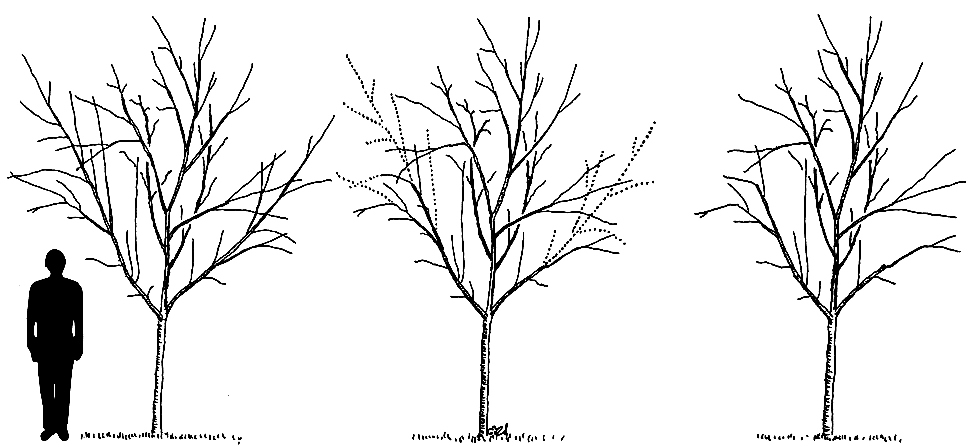| ||||||||
|
Structural Pruning Why prune | Tree structure | Pruning
cuts | Prune at planting | Structural pruning |
Sub-standard pruning | Is pruning needed Structural pruning is appropriate for trees of all ages. Pruning cuts will be small leaving insignificant
There are three basic steps to developing and maintaining a dominant leader. The first step is to identify the stem that will make the best dominant trunk. It should be in the center of the crown, and free of cracks, openings, mechanical damage, large pruning wounds, cankers or other defects that could compromise its strength. The second step is to identify the stems and branches that are competing with this stem. The last step is to remove competing stems and branches back to the trunk, or subordinate by shortening them with a reduction cut. Be sure to remove branches that are clustered together and growing from the same point on the trunk. Ideally, only one large branch grows from one position on the trunk. Here are examples of pruning many different tree types and sizes into a strong structure to help them live a long life. You will notice that for the most part, a balanced, aesthetically pleasing crown results from structural pruning.
In contrast to young trees, structural changes in older trees occur slowly because parts are much larger and growth has slowed. However, structural pruning is still recommended making two- to four-inch-diameter cuts on codominant stems and other weak limbs. Similar to small trees, the focus is on reducing the length of stems and branches that compete with the leader, and those with defects. Removing additional branches behind the reduction cut can suppress growth rate on the pruned stem even further. Unlike reduction cuts, removing only secondary lateral branches from stems and branches that compete with the leader on mature trees causes less dysfunctional wood behind pruning cuts. However, secondary branch removal does less to relieve mechanical stress along the pruned branch than reduction. Moreover, the branch may be forced to grow too long unless it is reduced in length with a reduction cut. |
| Copyright © 2011-2016 Urban Tree Foundation All rights reserved. |
|
This site funded by a grant from California Department of Forestry and Fire Protection Urban and Community Forestry Program 
|
|
Report problems with this web site to webmaster@urbantree.org |
|
[
Home |
Tree Quality |
Planting |
Pruning ] |
 wounds when pruning is conducted on a regular
basis. The objective is to prevent all branches and stems from growing larger than about half the diameter of the trunk. Young trees
respond quickly to structural pruning. Changes in branch diameter relative to trunk diameter (aspect ratio) brought about by structural
pruning are slower to manifest on medium-aged and mature trees than on younger trees because the core trunk and branch structure has
already been established. Prune often and begin at planting./p>
wounds when pruning is conducted on a regular
basis. The objective is to prevent all branches and stems from growing larger than about half the diameter of the trunk. Young trees
respond quickly to structural pruning. Changes in branch diameter relative to trunk diameter (aspect ratio) brought about by structural
pruning are slower to manifest on medium-aged and mature trees than on younger trees because the core trunk and branch structure has
already been established. Prune often and begin at planting./p>
